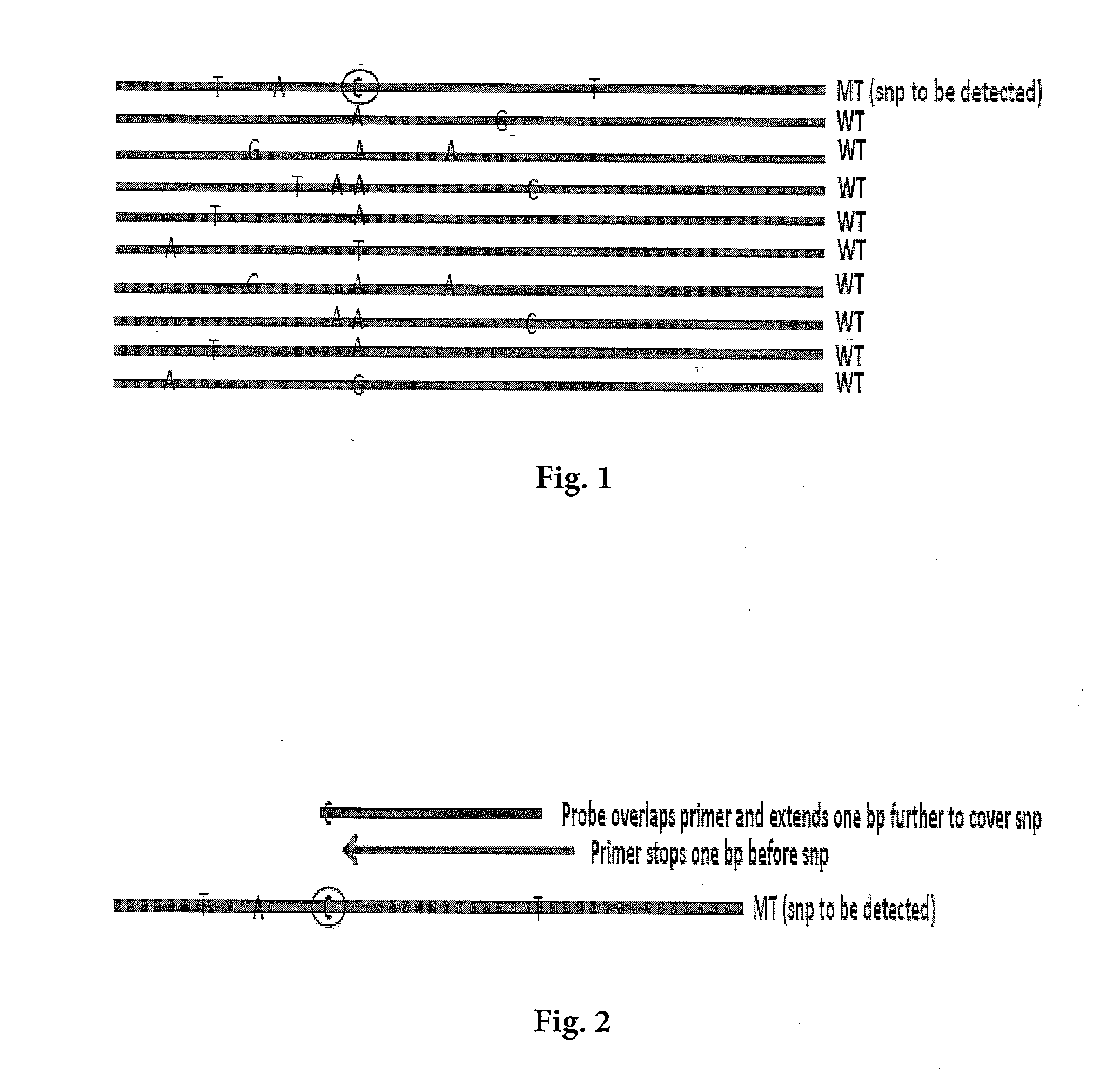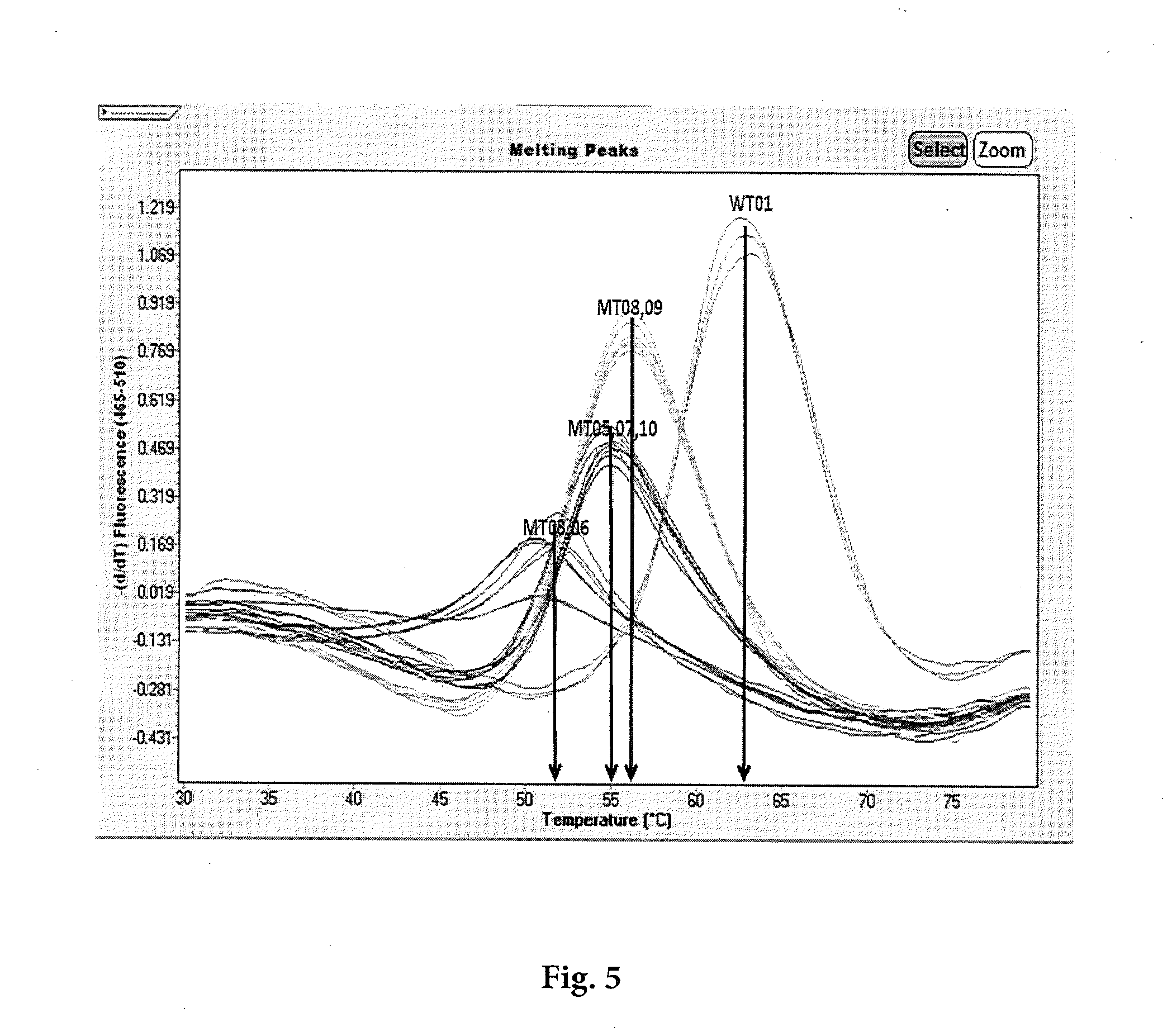Detecting Single Nucleotide Polymorphism Using Overlapped Primer and Melting Probe
- Summary
- Abstract
- Description
- Claims
- Application Information
AI Technical Summary
Benefits of technology
Problems solved by technology
Method used
Image
Examples
examples
[0075]The following examples and figures are provided to aid the understanding of the present invention, the true scope of which is set forth in the appended claims. It is understood that modifications can be made in the procedures set forth without departing from the spirit of the invention.
example i
Traditional Probe Melt Method
[0076]Referring to FIG. 5 and Table I, plasmid DNA (SEQ ID NOs: 2-9) were amplified using asymmetric PCR and immediately followed by melting analysis in a closed tube system. Asymmetric PCR contained an abundance of forward primer, limited reverse primer, and excess probe. The primers and probe design in this traditional probe melt method were designed not to overlap. The probe (SEQ ID NO: 1) was labeled at the 5′end with a fluorophore (F), and the 3′terminus with a black hole quencher (Q) which serves to quench the fluorescence of unbound probe and also to prevent amplification from probe extension.
TABLE ITargets and Probe for TraditionalProbe Melt MethodSEQIDNOSEQUENCE1Probe (WT)5′- FTGTGGGTCAACCCCGAQ -3′2Plasmid WT01A5′- CGCTTGTGGGTCAACCCCGA -3′3Plasmid MT03A5′- CGCTTGTCGGTCAACCCCGA -3′4Plasmid MT05A5′- CGCTTGCGGGTCAACCCCGA -3′5Plasmid MT06A5′- CGCTTGTAGGTCAACCCCGA -3′6Plasmid MT07A5′- CGCTTGAGGGTCAACCCCGA -3′7Plasmid MT08A5′- CGCTTGTGGGTCAACCCCTA -3′...
example ii
Overlapping Primer and Probe Melt Method with WT Probe
[0080]Referring to FIG. 6 and Table II, plasmid DNA (SEQ ID NOs: 12-19) was amplified using asymmetric PCR and immediately followed by melting analysis in a closed tube system. Asymmetric PCR contained an abundance of forward primer, limited reverse primer, and excess probe. The probe (SEQ ID NO: 11) was designed to overlap the reverse primer (SEQ ID NO: 10) and was designed in the same sense as the reverse primer in order to avoid probe-primer interaction. The probe was labeled at the 5′end with a fluorophore, and the 3′terminus with a black hole quencher which serves to quench the fluorescence of unbound probe and also to prevent amplification from probe extension.
TABLE IIarets and Stacked Primer and WT ProbeSEQIDNOSEQUENCE10Primer(WT)5′- GCGCTTGTGGGTCAACCCC -3′11Probe(WT)5′- FCGCTTGTGGGTCAACCCCGQ -3′12Plasmid WT015′- CGCTTGTGGGTCAACCCCG -3′13Plasmid MT035′- CGCTTGTCGGTCAACCCCG -3′14Plasmid MT055′- CGCTTGCGGGTCAACCCCG -3′15Plas...
PUM
| Property | Measurement | Unit |
|---|---|---|
| Melting point | aaaaa | aaaaa |
| Nucleic acid sequence | aaaaa | aaaaa |
| Fluorescence | aaaaa | aaaaa |
Abstract
Description
Claims
Application Information
 Login to View More
Login to View More - R&D
- Intellectual Property
- Life Sciences
- Materials
- Tech Scout
- Unparalleled Data Quality
- Higher Quality Content
- 60% Fewer Hallucinations
Browse by: Latest US Patents, China's latest patents, Technical Efficacy Thesaurus, Application Domain, Technology Topic, Popular Technical Reports.
© 2025 PatSnap. All rights reserved.Legal|Privacy policy|Modern Slavery Act Transparency Statement|Sitemap|About US| Contact US: help@patsnap.com



